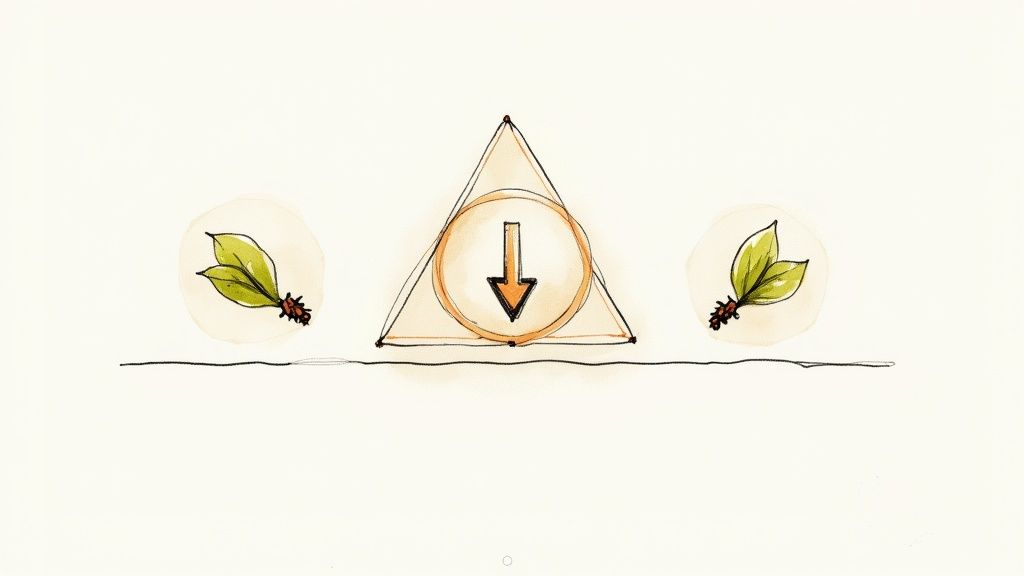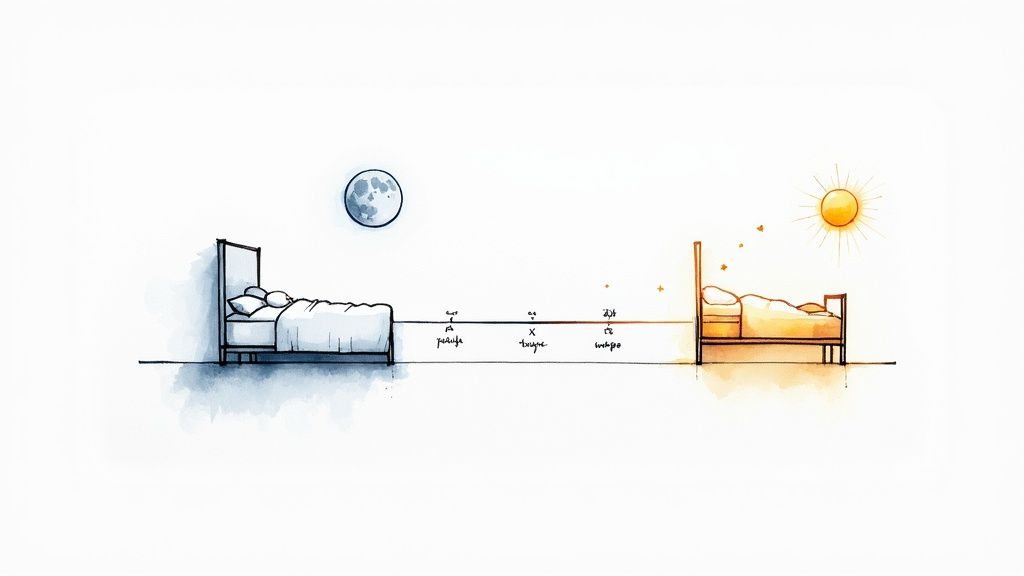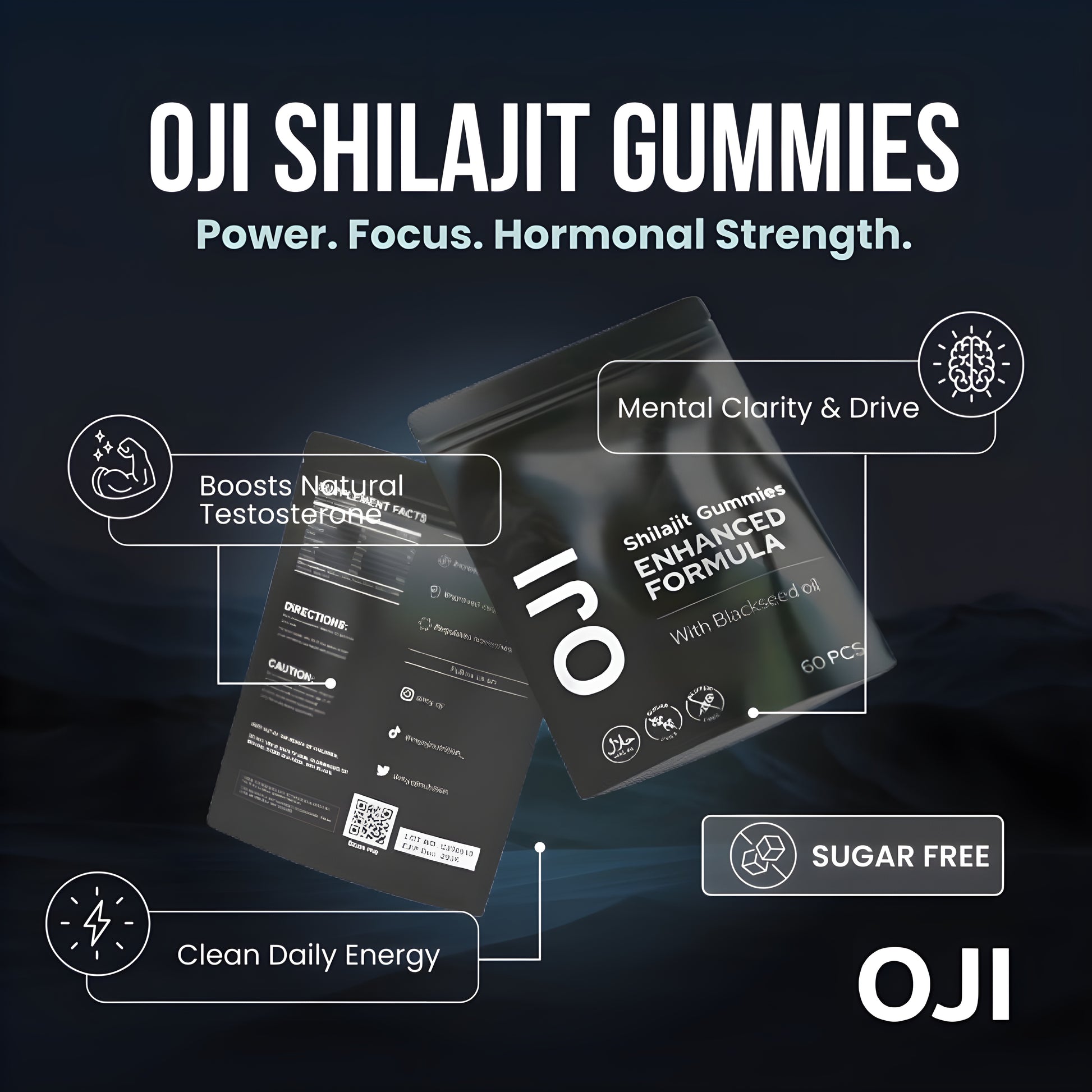In a world that runs on constant stimulation, reaching for another cup of coffee often feels like a default setting for productivity. Yet, the familiar cycle of jitters, heightened anxiety, and the inevitable afternoon crash leaves many searching for a better, more sustainable way to fuel their focus and vitality. This pursuit isn't just about avoiding the downsides of caffeine; it's about fundamentally upgrading your body's entire energy system from the ground up, building resilience that lasts all day.
This guide moves beyond temporary fixes. We will explore ten powerful, evidence-backed natural alternatives to caffeine designed to deliver consistent energy and mental clarity. Each strategy is an actionable tool for your daily routine, organised into distinct categories for easy navigation. You will learn how ancient adaptogenic herbs, modern biohacking techniques, strategic lifestyle shifts, and potent botanicals can help you reclaim your energy, sharpen your mind, and thrive without dependency. Many find that simple swaps, such as exploring the world of the best non-caffeinated teas, can be a valuable and flavourful starting point on this journey.
Prepare to discover practical methods for enhancing both cognitive function and physical stamina. We will cover specific implementation details for everything from targeted supplements like Rhodiola Rosea to fundamental practices like optimising your sleep. The goal is to provide a comprehensive toolkit, allowing you to choose the solutions that best fit your unique biology and lifestyle, and ultimately, to unlock a more stable and powerful source of personal energy.
1. L-Theanine & Green Tea
For a smoother, more focused energy lift, the combination of L-theanine and green tea stands out as one of the most effective natural alternatives to caffeine. While green tea does contain a modest amount of caffeine, its real power lies in its high concentration of L-theanine, an amino acid renowned for promoting a state of "alert calmness". This unique synergy is what sets it apart from the sharp jolt of coffee.

L-theanine works by increasing alpha brain waves, which are associated with a state of relaxed focus, similar to that achieved during meditation. When paired with caffeine, L-theanine tempers the less desirable side effects like jitters and anxiety, resulting in sustained mental clarity and productivity without the eventual crash. This powerful combination makes green tea an excellent tool for professionals needing to maintain concentration during a long workday or athletes seeking a calm focus before a competition.
How to Use L-Theanine & Green Tea
To maximise the benefits, use these preparation and timing actions. This is your plan for a clean start to your morning or overcoming the mid-afternoon slump.
- Brew Optimally: Brew your green tea at a lower temperature, around 70-82°C (160-180°F), for 2-3 minutes. This action preserves the delicate L-theanine and other beneficial compounds that are destroyed by boiling water.
- Upgrade to Matcha: For a more potent dose, use matcha powder. Since you consume the entire ground leaf, you get a much higher concentration of both L-theanine and antioxidants compared to traditionally brewed green tea.
- Take a Targeted Dose: For focused support, take L-theanine as a standalone supplement. A typical dose ranges from 100-200 mg. Use it as needed for focus.
- Time Your Intake: Consume in the morning or early afternoon to support daytime productivity without interfering with sleep.
Key Insight: The magic of green tea isn't just its caffeine content; it's the harmonious interaction between L-theanine and caffeine that creates a superior state of focused energy. This makes it a smarter, more balanced choice than high-caffeine drinks alone.
2. Adaptogenic Herbs (Rhodiola, Ashwagandha, Ginseng)
To build resilience against stress and achieve sustained energy, put adaptogenic herbs into your routine. As some of the most respected natural alternatives to caffeine, plants like Rhodiola, Ashwagandha, and Ginseng work by helping your body adapt to physical and mental stressors, thereby stabilising your energy levels. Instead of providing a temporary jolt like caffeine, adaptogens support your adrenal system to prevent fatigue and promote balanced vitality.

These herbs don't just mask tiredness; they help modulate the body's stress response system, particularly cortisol levels. Rhodiola is prized for its ability to combat fatigue and enhance cognitive function, making it a favourite among athletes and high-performers. Ashwagandha is renowned in Ayurvedic tradition for restoring vitality and calming the nervous system, while Ginseng has been used for millennia in Traditional Chinese Medicine to boost physical endurance and mental clarity. By promoting homeostasis, they provide a steady energy foundation without the risk of a crash. Learn more about how you can use adaptogens for energy.
How to Use Adaptogenic Herbs
To effectively incorporate adaptogens, follow these consistent and mindful actions. Their benefits are cumulative, building over time rather than providing an instant effect.
- Start with a Single Herb: Begin with one adaptogen, such as Rhodiola for daytime energy or Ashwagandha for stress support. This allows you to see how your body responds before you combine them.
- Cycle Your Intake: To maintain their effectiveness, cycle your adaptogens. A common protocol is to take them for six to eight weeks, followed by a one-week break.
- Choose Standardised Extracts: Opt for high-quality supplements that have a standardised extract. This ensures you get a consistent and potent dose of the active compounds in each serving.
- Time Your Doses: Take stimulating adaptogens like Rhodiola or Ginseng in the morning with food to support daytime energy. Take calming adaptogens like Ashwagandha in the afternoon or evening to help manage stress.
Key Insight: Adaptogens build foundational energy by helping your body manage stress more efficiently. They are a long-term strategy for sustained vitality, not a quick fix, making them a fundamentally different and more holistic approach than relying on caffeine.
3. Water Hydration & Electrolyte Balance
Often overlooked in the search for a quick fix, optimal hydration is one of the most powerful natural alternatives to caffeine for combating fatigue. Dehydration directly impairs physical and cognitive function by reducing blood volume, which forces your heart to work harder to deliver oxygen to your brain and muscles. This process is a common culprit behind the familiar afternoon slump many office workers experience.
Simply drinking enough water ensures your cells function correctly and your energy metabolism runs efficiently. When you add electrolytes-minerals like sodium, potassium, and magnesium-you enhance fluid absorption and support nerve signalling and muscle contraction. For instance, athletes often see significant performance improvements by maintaining this balance, while students can improve focus and test scores simply by staying consistently hydrated throughout the day.
How to Use Hydration for Energy
Take these strategic actions to turn water and electrolyte intake into a reliable energy source. The goal is to maintain hydration, not just correct it once you feel thirsty.
- Set Your Baseline: Aim for a minimum of 8-10 glasses of water daily. Increase this amount based on your activity level, climate, and body size.
- Front-Load Your Hydration: Start your morning by drinking a large glass of water (around 500ml or 16-20 oz) before anything else to rehydrate after sleeping. This action kick-starts your metabolism and brain function.
- Add Electrolytes Strategically: During intense exercise, hot weather, or illness, add an electrolyte powder to your water or drink mineral-rich spring water to replenish what’s lost through sweat.
- Monitor Your Hydration Status: Check your urine colour. A pale, straw-like yellow indicates good hydration, while darker yellow or amber means you need to drink more water.
- Make Water Accessible: Keep a reusable water bottle on your desk or with you throughout the day. Use it as a constant visual reminder to drink.
Key Insight: Fatigue is one of the first signs of dehydration. Before reaching for a stimulant, drinking a large glass of water with a pinch of high-quality sea salt can often restore energy levels more effectively and sustainably than caffeine.
4. Intermittent Fasting & Strategic Meal Timing
To overhaul your energy system from the ground up, implement intermittent fasting (IF) and strategic meal timing as a powerful, non-consumable natural alternative to caffeine. Rather than adding a stimulant, this approach optimises your body's innate ability to produce stable energy. By cycling between periods of eating and voluntary fasting, you encourage metabolic flexibility, allowing your body to efficiently switch from burning glucose to burning fat for fuel. This process helps to eliminate the energy peaks and troughs associated with constant eating.
This metabolic shift is why many high-performers, from Silicon Valley entrepreneurs to elite athletes, adopt IF. They report enhanced mental clarity and sustained afternoon energy, avoiding the typical 2-3pm crash that sends many reaching for another coffee. Intermittent fasting leverages your body's natural circadian rhythms and cellular clean-up processes (autophagy) to create a more resilient and efficient energy production system, providing clean, jitter-free vitality throughout the day.
How to Use Intermittent Fasting & Strategic Meal Timing
Integrate IF using a gradual approach to allow your body to adapt. The action plan is to align your eating schedule with your body's natural rhythms for optimal energy and focus.
- Start Gradually: Begin with a 12-hour fast (e.g., stop eating at 8 pm and eat breakfast at 8 am). Once comfortable, slowly extend the fasting window to 14 or 16 hours, creating an 8-hour eating window (the popular 16:8 method).
- Break Your Fast Wisely: Make your first meal after a fast nutrient-dense. It should be rich in protein and healthy fats to replenish your body and sustain stable blood sugar levels. Avoid breaking your fast with sugary or high-carbohydrate foods.
- Stay Hydrated: During your fasting window, drink plenty of water. Unsweetened herbal tea and black coffee are also permissible and can help manage hunger.
- Time Your Workouts: For best results, align your workouts. Perform strength training during your eating window, when fuel is readily available, for the most effective session.
Key Insight: Intermittent fasting is not about calorie restriction but about when you eat. By strategically timing your meals, you train your body to become a more efficient energy-producing machine, reducing your reliance on external stimulants like caffeine for focus and vitality.
5. High-Intensity Interval Training (HIIT) & Movement
For a powerful, self-generated energy boost, use strategic physical activity as one of the most effective natural alternatives to caffeine. High-Intensity Interval Training (HIIT) in particular offers a rapid and lasting increase in vitality. This method involves short bursts of intense, all-out effort followed by brief recovery periods, which triggers a potent physiological response far superior to the temporary lift from a stimulant.
HIIT works by igniting your metabolism, increasing mitochondrial density (the powerhouses of your cells), and improving overall cardiovascular efficiency. This process releases a cascade of endorphins and hormones like adrenaline and noradrenaline, which directly enhance alertness and focus. Unlike the artificial stimulation of caffeine, this energy is generated from within, making it more sustainable and free from the dreaded crash. Many professionals use quick 10-minute stairwell sprints to overcome afternoon slumps, proving that even a short session can reset your energy for hours.
How to Use HIIT & Movement
Integrate short, sharp bursts of exercise into your routine to harness your body’s natural energy production. Follow these actional steps for consistency and proper timing.
- Start Your Morning with Ignition: Perform a 10-15 minute HIIT session in the morning. Exercises like burpees, high knees, or sprints can elevate your metabolic rate and sustain energy levels throughout the workday.
- Take a Micro-Break: Instead of reaching for a coffee, take a five-minute movement break every hour. Stand up, stretch, or perform a quick set of squats or press-ups to improve blood flow and fight off lethargy.
- Schedule Structured Sessions: Aim for 2-3 dedicated HIIT sessions per week, combined with strength training. This builds a more resilient and efficient energy system over time.
- Fuel and Recover Properly: Ensure you are properly fuelled before exercise and allow for adequate recovery between intense sessions to prevent burnout and maximise benefits.
Key Insight: The energy from HIIT is not just a feeling; it's a fundamental improvement in your cellular and metabolic function. By training your body to be more efficient, you create a lasting source of natural vitality that caffeine can only temporarily mimic.
6. Vitamins & Minerals (B-Complex, CoQ10, Magnesium)
Instead of stimulating the nervous system, focus on fuelling your body's foundational energy production. B-vitamins, Coenzyme Q10 (CoQ10), and magnesium are essential cofactors in the cellular process that creates adenosine triphosphate (ATP), the body's primary energy currency. When these micronutrients are deficient, which is remarkably common, fatigue and sluggishness are often the direct results, making replenishment one of the most effective natural alternatives to caffeine.
The B-complex vitamins act as catalysts in converting the food you eat into usable energy. CoQ10 is critical for mitochondrial function, the powerhouses within your cells, while magnesium is involved in over 300 biochemical reactions, including energy creation and nervous system regulation. By ensuring you have adequate levels of these key nutrients, you support your body’s inherent ability to produce and sustain energy, preventing the deep-seated fatigue that caffeine can only temporarily mask. This method is particularly vital for athletes needing optimal performance or professionals facing persistent mental drain.
How to Use Vitamins & Minerals
For this strategy to be effective, take consistent, properly formed, and timed supplements. The goal is to correct underlying deficiencies and support ongoing cellular energy. For a deeper look, you can learn more about how to boost energy with vitamins on myoji.co.uk.
- Choose a B-Complex: Take a comprehensive B-complex supplement to get the synergistic benefits of all B vitamins. For better bioavailability, look for methylated forms like methylcobalamin (B12) and methylfolate (B9). Take it with breakfast to support energy metabolism throughout the day.
- Absorb CoQ10 Effectively: CoQ10 is fat-soluble, so take it with a meal containing healthy fats (like avocado or olive oil) to maximise absorption. A typical dose for energy support is 100-200 mg daily.
- Time Your Magnesium: Magnesium glycinate is an excellent choice as it is highly absorbable and gentle on the stomach. Start with 200-400 mg daily, taken in the evening to support restorative sleep, which directly impacts next-day energy levels.
- Get Tested: If you suspect a deficiency, especially in B12 or magnesium, ask your doctor for blood testing. This provides a clear picture and guides more targeted supplementation.
Key Insight: True, sustainable energy isn't about stimulation; it's about production. Addressing micronutrient deficiencies with targeted vitamins and minerals fixes the root cause of fatigue at a cellular level, providing a stable energy foundation that caffeine cannot replicate.
7. Meditation & Breathwork (Pranayama)
For a truly stimulant-free boost, meditation and controlled breathing (pranayama) offer profound and immediate effects. Put these practices into action as powerful natural alternatives to caffeine by directly influencing your nervous system and physiology. Instead of introducing an external substance, you are harnessing your body’s innate ability to generate energy, focus, and calm on demand.

These techniques work by increasing oxygen supply to the brain, activating the parasympathetic nervous system (our "rest and digest" state), and lowering levels of the stress hormone cortisol. The result is a clean, centred energy that enhances mental clarity without the jitters or subsequent crash associated with caffeine. It's no surprise that Navy SEALs use box breathing for performance under pressure and Silicon Valley executives rely on meditation to maintain focus and drive innovation.
How to Use Meditation & Breathwork
Integrate these practices into your daily routine to create a sustainable foundation of energy. Instead of reaching for another cup of coffee when the 3 PM wall hits, take action and explore powerful breathing for energy techniques to reboot your day.
- Start Small: Begin with just 5-10 minutes each morning. Consistency is more important than duration. Use apps like Headspace or Insight Timer for helpful guidance.
- Try Box Breathing: For an instant boost of calm focus, inhale for a count of four, hold for four, exhale for four, and hold for four. Repeat this cycle for several minutes to balance your nervous system.
- Practice Energising Breaths: Explore the Wim Hof Method, which involves rounds of 30 deep, rapid breaths followed by a breath-hold. This technique is renowned for its powerful energising and mood-lifting effects.
- Schedule Your Practice: A morning session sets a productive and calm tone for the entire day. A short breathwork break in the afternoon can effectively combat fatigue.
Key Insight: Unlike caffeine, which borrows energy from your future reserves, meditation and breathwork generate new, sustainable energy from within. This approach not only boosts immediate focus but also builds long-term resilience to stress.
8. Nutritional Superfoods (Organic Fruits, Nuts, Seeds, Dark Leafy Greens)
One of the most foundational natural alternatives to caffeine involves shifting your focus from quick fixes to sustainable fuel. Nutritional superfoods, including organic fruits, nuts, seeds, and dark leafy greens, provide the body with a steady stream of energy by stabilising blood sugar levels and delivering a rich profile of essential micronutrients. Unlike the sharp spike and subsequent crash from caffeine, this approach builds a reliable energy baseline from the ground up.
These foods work by providing a balanced combination of complex carbohydrates, healthy fats, and proteins. This trifecta slows down digestion and the absorption of sugars into the bloodstream, preventing the glucose rollercoaster that leads to energy slumps. For instance, athletes often pair fruit with nuts for post-workout recovery, utilising the combination for sustained energy release, while professionals may start their day with eggs and avocado to maintain mental clarity for hours.
How to Use Nutritional Superfoods
Integrating these foods effectively means creating balanced and consistent eating habits. The goal is to nourish your body with the building blocks it needs for all-day energy, making it less reliant on external stimulants.
- Build Balanced Plates: For every meal, include a source of protein (like eggs or seeds), healthy fat (like avocado or nuts), and fibre-rich complex carbohydrates (from fruits or leafy greens) to ensure stable energy.
- Snack Smarter: Combine an apple with a handful of almonds or a piece of dark chocolate for a mid-afternoon snack. This pairing provides a quick energy boost from the fruit, which is then sustained by the fat and protein.
- Prepare Meals in Advance: Prepare overnight oats with chia seeds and berries for a ready-made, energy-stabilising breakfast. Having pre-cut vegetables and mixed nuts accessible prevents you from reaching for less healthy, energy-draining options.
- Time Your Meals: Consume these balanced meals and snacks throughout the day. Eating smaller, more frequent meals can help maintain stable glucose levels and prevent the lethargy that often follows large, carb-heavy meals.
Key Insight: True, sustainable energy is built, not borrowed. By fuelling your body with a consistent intake of nutrient-dense whole foods, you create a stable metabolic foundation that reduces the need for artificial stimulants like caffeine.
9. Cold Exposure & Contrast Therapy
For a powerful, non-ingestible energy boost, implement cold exposure and contrast therapy as a potent physiological reset. This method stands out as one of the most immediate natural alternatives to caffeine, leveraging the body's innate survival mechanisms to create a surge of alertness and mental clarity. By activating the sympathetic nervous system, a blast of cold water triggers a significant release of norepinephrine, a key neurotransmitter responsible for focus, attention, and mood.
Popularised by figures like Wim Hof and adopted by elite groups such as Navy SEALs, this practice involves intentionally exposing the body to cold temperatures through cold showers, ice baths, or cryotherapy. This controlled stressor increases metabolic rate and sharpens focus without the risk of a subsequent crash. When combined with heat, as in contrast therapy (alternating between cold and hot), it further enhances circulation and promotes a state of calm alertness, making it ideal for professionals seeking peak mental performance or athletes aiming for enhanced recovery and vitality.
How to Use Cold Exposure & Contrast Therapy
Integrating this practice requires a gradual approach to build tolerance and maximise the energising benefits. It is most effective when performed in the morning to set a resilient tone for the day.
- Start Small: Begin by finishing your regular warm shower with just 30 seconds of cold water. Focus on controlled, deep breathing to manage the initial shock.
- Progress Gradually: Over several weeks, increase the duration to 60-90 seconds. The goal is to adapt your body's response, not to endure discomfort unnecessarily.
- Introduce Contrast: For a more advanced approach, alternate between one minute of cold water and one minute of hot water, repeating for 3-5 cycles. Always end on cold to retain the alertness benefits.
- Time Your Practice: Use morning exposure for a sustained energy boost that lasts throughout the day without interfering with sleep patterns.
Key Insight: The power of cold exposure lies in its ability to trigger a potent neurochemical response. The sharp increase in norepinephrine provides a clean, lasting surge of energy and focus that rivals, and in many ways surpasses, the artificial stimulation of caffeine.
10. Sleep Optimization & Circadian Rhythm Alignment
Before reaching for any stimulant, the most foundational and powerful action is to optimise your sleep. This is often overlooked, but no supplement can truly compensate for poor sleep. Quality rest and a properly aligned circadian rhythm are the ultimate natural alternatives to caffeine, providing the cellular and mental restoration necessary for high performance. Misalignment depletes energy reserves far more than any external booster can replace.

The body’s internal clock, or circadian rhythm, governs our sleep-wake cycles and energy levels. When this rhythm is synchronised with natural light and dark cycles, energy peaks during the day and dips at night, promoting restorative sleep. This biological process is championed by experts like Dr. Matthew Walker and neuroscientist Andrew Huberman, who highlight its critical role in everything from cognitive function to physical recovery. For example, knowledge workers often report significant productivity gains with consistent sleep, while athletes can see measurable performance improvements.
How to Use Sleep Optimization & Circadian Rhythm Alignment
Take these actions to build consistent habits that signal to your body when it's time to be alert and when it's time to rest. These practices are designed to be implemented daily for long-term energy stability.
- Maintain Consistency: Go to bed and wake up within the same 30-minute window every day, even on weekends. This consistent action is the single most important factor in anchoring your circadian rhythm.
- Get Morning Sunlight: Within 30-60 minutes of waking, get outside for 10-15 minutes of direct sunlight exposure. This powerful signal helps to reset your internal clock for the day ahead.
- Create an Ideal Sleep Environment: Keep your bedroom cool (around 16-19°C), completely dark with blackout curtains, and quiet. This environment optimises the production of melatonin, the sleep hormone.
- Establish a Wind-Down Routine: An hour before bed, avoid screens and engage in relaxing activities like reading a physical book, gentle stretching, or meditation. This helps transition your brain and body into a state of rest.
- Track Your Metrics: Consider using a wearable device like an Oura Ring or Whoop to monitor sleep stages and recovery. This data provides valuable insights into how your habits affect your sleep quality.
Key Insight: True energy isn't created by stimulants; it's restored through deep, restorative sleep. Prioritising sleep hygiene and circadian alignment provides a baseline of vitality that makes external energy sources less necessary and more effective when used.
Comparison of 10 Natural Alternatives to Caffeine
| Approach | Implementation (🔄) | Resources (⚡) | Expected outcomes (⭐) | Ideal use cases (💡) | Key advantages (📊) |
|---|---|---|---|---|---|
| L-Theanine & Green Tea | Low — simple brew or supplement | Low — tea or 100–200 mg doses | Smooth, sustained focus; reduced anxiety | Morning focus, study, gentle alertness | No jitters/crash; antioxidant benefits |
| Adaptogenic Herbs (Rhodiola, Ashwagandha, Ginseng) | Moderate — daily dosing, cycling advised | Moderate — standardized extracts; costlier brands | Gradual stress reduction; sustained energy over weeks | Chronic stress, endurance training, resilience building | Hormone regulation; non‑habit forming |
| Water Hydration & Electrolyte Balance | Low — habit formation | Very low — water + occasional electrolytes | Immediate restoration of alertness and cognition | Everyday use, exercise, hot climates | Fast, safe, low‑cost; broad health effects |
| Intermittent Fasting & Strategic Meal Timing | Moderate‑High — planning and adaptation period | Low‑Moderate — meal timing, some prep | Stable energy, improved metabolic efficiency | Weight management, productivity blocks, metabolic health | Reduces sugar crashes; supports autophagy |
| HIIT & Movement | Moderate — requires effort and warm‑up | Low — short time investment; minimal equipment | Strong immediate + hours‑long energy boost | Quick energy before work, mood lift, fitness goals | Most powerful natural energy booster; improves sleep |
| Vitamins & Minerals (B‑Complex, CoQ10, Magnesium) | Low‑Moderate — testing and consistent dosing | Low — supplements; possible blood tests | Corrects deficiencies; sustained cellular energy over weeks | Suspected deficiency, vegans, older adults, recovery | Targets ATP production; multiple systemic benefits |
| Meditation & Breathwork (Pranayama) | Low — requires practice for potency | Very low — time; apps optional | Immediate calming or energizing clarity | Stress management, quick focus resets, portable | Zero cost, portable, no side effects |
| Nutritional Superfoods (Fruits, Nuts, Greens) | Moderate — meal planning and prep | Moderate — food cost and storage | Stable blood sugar and sustained daytime energy | Daily nutrition foundation, athletes, recovery | Broad nutrition, sustained satiety, no negatives |
| Cold Exposure & Contrast Therapy | Moderate‑High — acclimation and safety needs | Moderate‑High — equipment or facilities | Immediate alertness; increased norepinephrine and circulation | Morning alertness, recovery protocols, resilience training | Powerful immediate effect; metabolic and immune benefits |
| Sleep Optimization & Circadian Alignment | Moderate — routine and environment changes | Low — may need blackout, tracking tools | Largest long‑term gains in sustained daytime energy | Universal foundation for performance and cognition | Most impactful; multiplies benefits of other methods |
Your Action Plan for Caffeine-Free Vitality
Embarking on a journey to find natural alternatives to caffeine is not about simply removing something from your routine; it's about fundamentally upgrading your body's innate energy systems. We've explored a comprehensive toolkit of ten powerful strategies, moving far beyond a simple one-for-one swap and into the realm of building sustainable, self-generated vitality. This is not about deprivation, but about liberation from the highs and lows of the stimulant cycle.
The path forward is about creating a resilient foundation. While quick boosts from high-intensity interval training or the invigorating shock of cold exposure offer immediate, palpable lifts in alertness, their true power is unlocked when built upon a bedrock of consistency. Think of foundational practices like sleep optimisation and proper hydration not as mere checklist items, but as powerful force multipliers that amplify the benefits of everything else you do.
Crafting Your Personalised Energy Protocol
The sheer number of options can feel overwhelming, but the key is to start small and build momentum. The goal is not to implement all ten strategies overnight, but to create a personalised protocol that seamlessly integrates into your lifestyle. A practical approach is to layer these methods, creating a synergistic effect that caffeine alone could never replicate.
Here’s a structured action plan to begin your transition:
-
Step 1: Identify Your Primary Challenge. Are you battling the 3 PM slump, morning grogginess, or a general lack of focus? Pinpointing your main energy drain helps you select the most relevant alternatives. For instance, if afternoon fatigue is your nemesis, a short HIIT session or a mindful walk combined with strategic hydration could be far more effective than another coffee.
-
Step 2: Choose Your 'Foundation' and 'Booster'. Select one foundational habit and one targeted 'booster' to implement this week.
- Foundation Action: Commit to aligning with your circadian rhythm by avoiding screens for 60 minutes before bed.
- Booster Action: Swap your usual morning coffee for a high-quality green tea to benefit from the calming focus of L-Theanine.
-
Step 3: Track and Adapt. Pay close attention to how your body responds. Do you feel more stable energy throughout the day? Is your focus sharper? Use a simple journal to note your energy levels, mood, and productivity. This feedback loop is crucial for refining your approach and building a routine that truly works for you.
The Synergy of a Holistic Approach
The real magic happens when these diverse elements begin to work in concert. Imagine a day where your energy is not dictated by a chemical stimulant, but by your own optimised biology. You might start with pranayama breathwork to oxygenate your system, fuel your morning with nutrient-dense superfoods instead of a pastry, and use an adaptogen like Rhodiola to manage midday work stress. This holistic approach builds a robust energy architecture that is resilient, stable, and entirely your own.
Mastering these concepts is about reclaiming your sovereignty over your own energy. It’s about cultivating a state of being where mental clarity, physical stamina, and emotional resilience are your default, not a temporary state borrowed from a stimulant. By choosing these natural alternatives to caffeine, you are investing in long-term health, hormonal balance, and a higher quality of life, freeing yourself to perform at your peak, consistently and sustainably. This is the ultimate form of empowerment.
Ready to supercharge your foundational health and simplify your energy routine? Oji Shilajit offers a potent blend of over 84 essential minerals and fulvic acid, directly addressing the nutrient gaps that often lead to fatigue. By supporting cellular energy production and enhancing resilience, our Shilajit gummies provide a powerful, convenient baseline for your caffeine-free journey. Discover the benefits of Oji Shilajit and take the first step towards sustained vitality.





